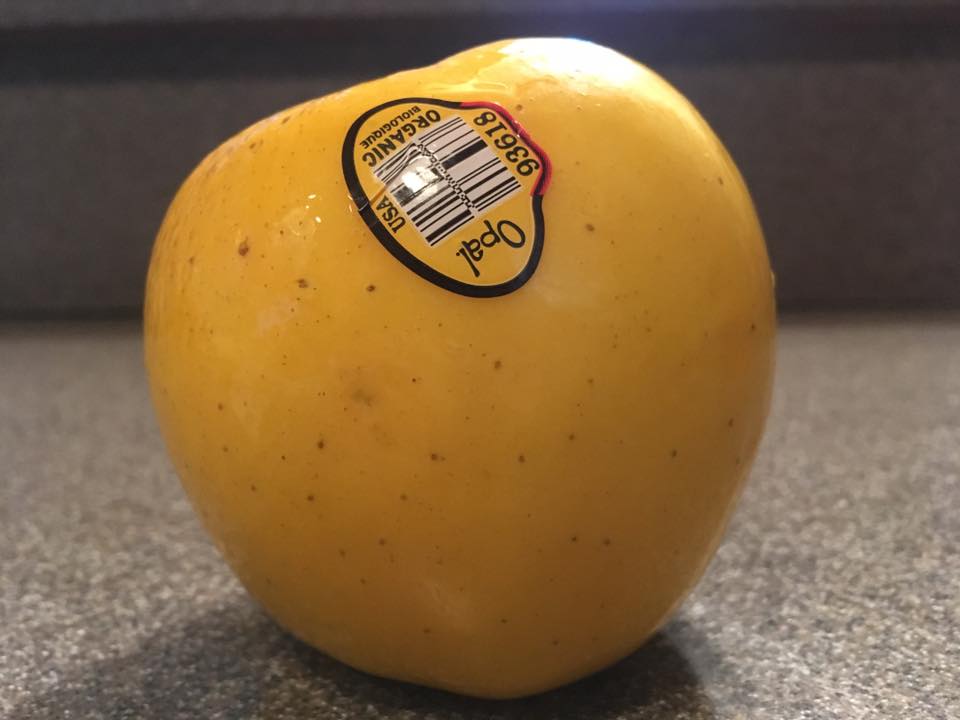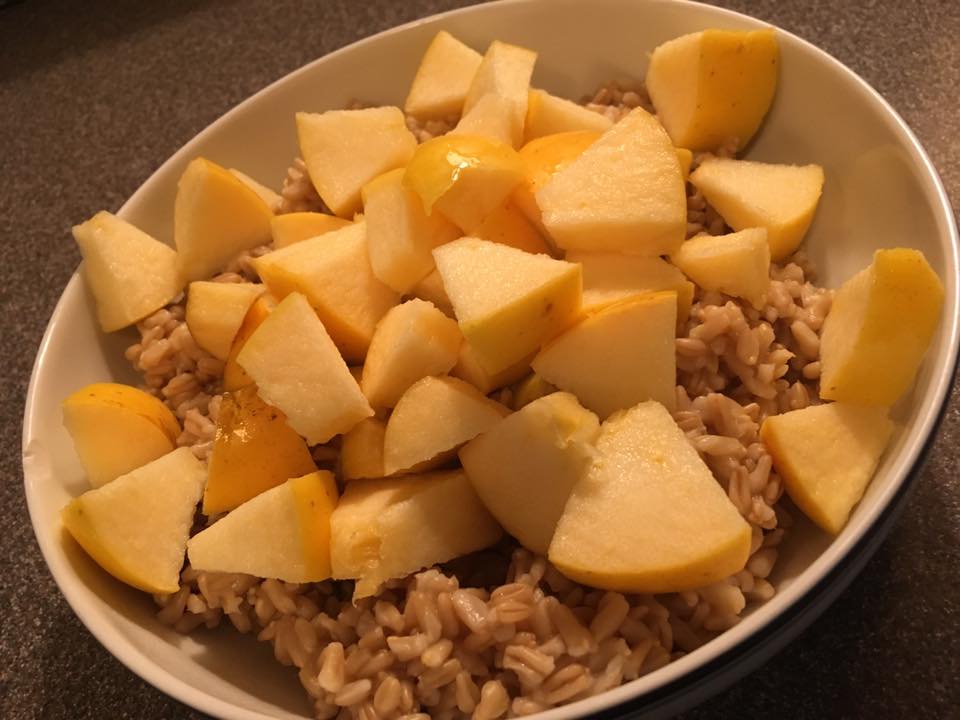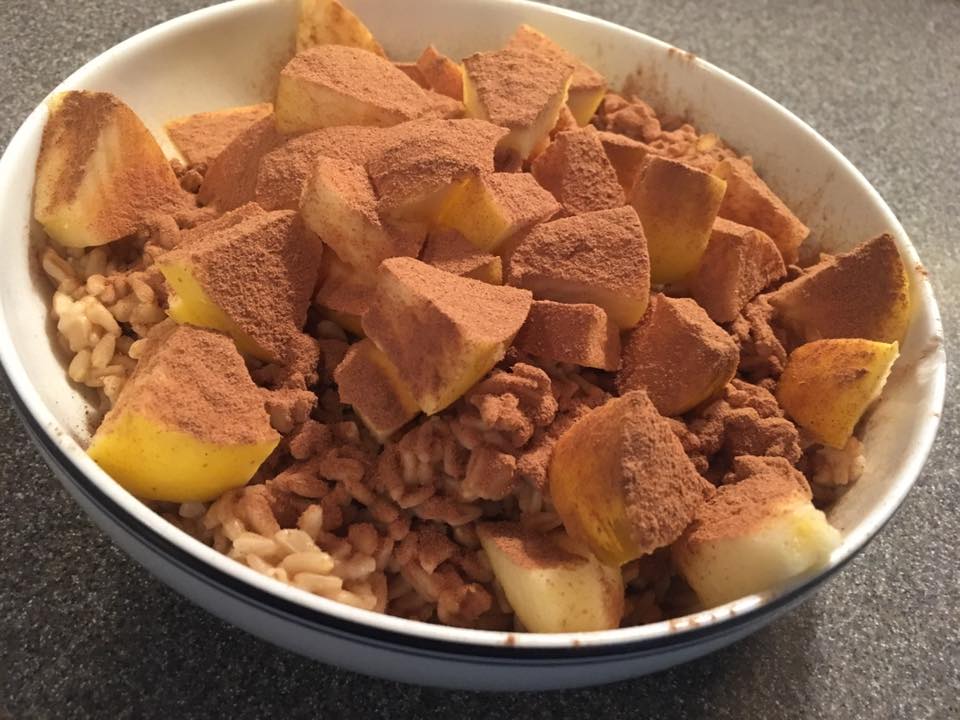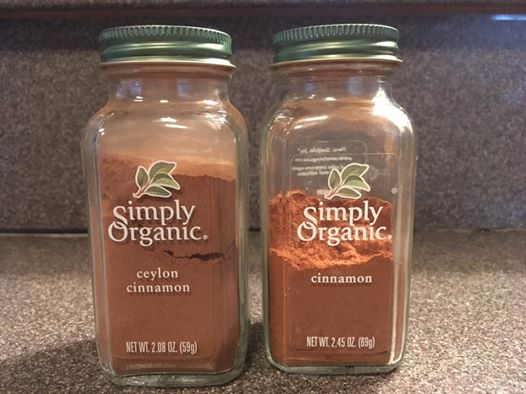I learned a nutrition fact recently at an informative local Palmetto Plant Eaters Club meeting that changed my morning routine. Since purchasing an Instant Pot, most mornings I make and consume oat groats for breakfast. Typically I will top the groats with strawberries or apples (often organic Granny Smith or Honeycrisp) and a thorough – and I mean thorough – covering of cinnamon spice.

Lately I’ve been enjoying organic Opal apples with the groats and cinnamon and have changed my spice from Cinnamomum cassia (or standard cinnamon spice) to strictly Ceylon cinnamon for reasons I’ll explain below.
Cinnamon is a spice obtained from the inner bark of several tree species from the genus Cinnamomum. A number of species are often sold as cinnamon:
• Cinnamomum cassia (cassia or Chinese cinnamon, the most common commercial type)
• Cinnamomum burmannii (Korintje, Padang cassia, or Indonesian cinnamon)
• Cinnamomum loureiroi (Saigon cinnamon, Vietnamese cassia, or Vietnamese cinnamon)
• Cinnamomum verum (Sri Lanka cinnamon or Ceylon cinnamon)
• Cinnamomum citriodorum (Malabar cinnamon)
• Cinnamomum tamale (Indian cinnamon)
Cassia is the strong, spicy flavour associated with cinnamon rolls and other such baked goods as it handles baking conditions well. Chinese cinnamon is generally a medium to light reddish brown, hard and woody in texture and thicker as all of the layers of bark are used.
Ceylon cinnamon, using only the thin inner bark, has a lighter brown colour, a finer, less dense and more crumbly texture, and is considered to be subtler and more aromatic in flavour than cassia, losing much of its flavour during cooking.
Levels of the naturally occurring blood-thinning agent coumarin in Ceylon cinnamon are much lower than those in cassia. (source) And herein lies the reason for change in my morning routine. I had been using standard cinnamon up until I learned about the toxicity potential. Immediately I switched to organic Ceylon cinnamon.
Below is a photo of my morning groats topped with chopped Opal apple:

The European Food Safety Authority in 2008 considered toxicity of coumarin, known to cause liver and kidney damage in high concentrations and a significant component of cinnamon, and metabolic effect on humans with CYP2A6 polymorphism, and confirmed a maximum recommended tolerable daily intake (TDI) of 0.1 mg of coumarin per kg of body weight. The European Union set a guideline for maximum coumarin content in foodstuffs of 50 mg (0.01 teaspoon) per kg of dough in seasonal foods, and 15 mg (0.003 teaspoon) per kg in everyday baked foods.
According to the maximum recommended TDI of 0.1 mg of coumarin per kg of body weight, which is 5 mg (0.001 teaspoon) of coumarin for a body weight of 50 kg (110 pounds).
Due to the unpredictable amount of coumarin in Cinnamomum cassia, usually well over 1,000 mg of coumarin per kg of cinnamon and sometimes up to 12 times that, Cinnamomum cassia has a very low safe intake level to adhere to the above TDI. (source)
Below is a photo of my groats and apple with a typical thorough covering of cinnamon:

You can see why it was very important that I immediately switch over to Ceylon! I love an ample dose of cinnamon on my breakfast!

One teaspoon of cassia cinnamon (or just”cinnamon”) powder contains 5.8 to 12.1 mg of coumarin, which may be above the tolerable daily intake value for smaller individuals. Coumarins have an influence on the development of the brain which can lead to mild neurologic dysfunctions in children of school age.(source)
Cassia cinnamon powder may contain up to 63 times more coumarin than ceylon cinnamon. Cassia cinnamon has the potential to interact with a variety of different medications, including those used to control diabetes. Don’t take it if you use any medication that can harm the liver, including acetaminophen. You should not mix cinnamon supplements with herbs that affect the liver or lower blood sugar. A partial list of these herbs includes red yeast, fenugreek, garlic and ginseng. (source)
Taking large amounts of cassia cinnamon might cause interactions with certain medications, and these interactions could lead to liver damage. These medications include statin medications, acetaminophen, the heart medication amiodarone, the seizure medication carbamazepine, medications for treating fungal infections, the cancer medication methotrexate and the blood pressure medication methyldopa. Because of cinnamon’s potential for lowering blood sugar levels, large amounts of it may interact with diabetes medications and cause low blood sugar. Cassia cinnamon may also potentially interact with tetracycline. (source)
Coumarin may also interact with other drugs including aspirin, NSAIDs (ibuprofen, naproxen, etc) and other anticoagulants such as warfarin (Coumadin). (source)
Additional warnings and side-effects can be read here. Regardless of whether you take medications or supplements, it would probably be safe for all of us to make the switch over to Ceylon cinnamon.

{ 14 comments… read them below or add one }
U didnt finish of explaining about whether cinamon burmannii is good or bad regards jules
Cinnamon burmannii is not commonly sold here in America and I’m sorry that I don’t know much about it. Please tell me what you know about it. Thank you!
C. burmannii IS commonly sold in the US, particularly in the supplements that so many people rely on for their A1c lowering herbal remedies. It has MORE coumarin in it, on average, than C. cassia. They use C. burmannii in Cinsulin, which use a water extraction process on the cinnamon to remove the coumarin as it is not water soluble, but what you are left with after that, I have no idea what the “proper” dosage would be to lower your A1c, triglycerides, and/or cholesterol. If it is 1:1 (eg 1g of real cinnamon = 1 g of cinnamon extract in Cinsulin) then it is incredibly expensive. You would have to take 12 capsules every day to get to 6 g, and the cheapest I’ve sen it is 12c per capsule, so a month’s supply at that rate would be about $34, compared to about $8 for the more common unfiltered natural cinnamon, most of which is cassia regardless of the label. Remember the FDA does not monitor supplements AT ALL. They monitor everything from flour to ice cream for purity and authenticity, but supplements? You are on your own and the adulteration and fakery is truly phenomenal. The only way to be safe is to buy the Ceylon cinnamon whole (because you CAN tell by looking at the whole spice whether it is Ceylon or something else), grind it yourself, and put it in capsules yourself. I know of no other way – we can’t be sprinkling it on oatmeal or ice cream or whatever y’all are sprinkling it on because we are DIABETIC and can’t eat any of the high carb foods that are commonly suggested. That includes fruit.
The powdered form is not safe either. The difference between ground Ceylon and ground cassia is color, and color is easily lightened as simply as by adulterating the ground cinnamon with rice powder. The only way to be safe and still take the large amounts required for medical efficacy is to buy it whole and process it yourself. A coffee grinder will do.
I have approved your comments only because something you have written may help someone else. I will neither confirm nor deny the information you provided. I would however encourage you to research the contribution of dietary fat to the development of diabetes 2 which is primarily a fat problem that then causes a sugar problem. Whole carbs and starches like fruit, grains, and legumes (not ice cream) have helped many people reverse their diabetes. You can research the work done by Dr. Neal Barnard who has assisted many patients with reversing their diabetes with a whole food, plant-based diet which is naturally low in fat.
Cinnamomum burmannii Is sold in walgreens under the finest healthy nutrition supplements in the U.S.
I have just about finished off a 1lb bag of organic Cinnamon Burmanii, which is Cassia, from Indonesia, distr. by StarWest Botanicals. I just opened a 1lb bag of organic Cinnamon Vera from Ceylon, distr. by Frontier Co-op. I purchased both from Lucky Vitamin (internet). The Burmanii was similar to all the “Cinnamon” (Cassia) I have ever tasted. I just compared the 2 on some buttered toast. The Ceylon Cinnamon is certainly different – darker, not lighter, than the Burmanii, and I wouldn’t considered to be subtler. It is more aromatic than the more pungent Cassia. I like them both. I look forward to using the Ceylon Cinnamon where I have been using Cassia (which I always thought was Cinnamon).
Thank you for sharing your findings with us!
If your ceylon cinnamon was darker, you got cheated. Period paragraph. That was not ceylon cinnamon. As I said, the only way to be sure is to buy the stuff whole.
I just purchased some cinnamomum burmannii from my local flour mill, and while “Indonesian cinnamon” goes by some other names that include the word “cassia,” it turns out it’s not cassia cinnamon. Cinnamomum cassia is “cassia cinnamon.” Cinnamomum burmannii is burmannii cinnamon. Just fyi.
Thank you for contributing these details Jen!
Here is an article with their take on Cinnamon, including the Burmanii variety:
https://blog.gaiaherbs.com/2016/04/07/the-real-deal-with-cinnamon/
I am working on a batch of Cinnamon Burmanii myself, so I probably need to go easy on it until I get some Ceylon.
Gaia Herbs is a trusted source. Thank you!
Coumarin is not water soluble. Use cassia or burmanni to make cinnamon tea. Drink the best parts, toss the rest. Several studies confirm that fact, and advise hot water extraction. I use a small coffee maker, place tea in the paper filter, sprinkle cassia or burmanni on top of that. Works the same with coffee grounds.
Good to know this option. Thanks for adding it Noah!